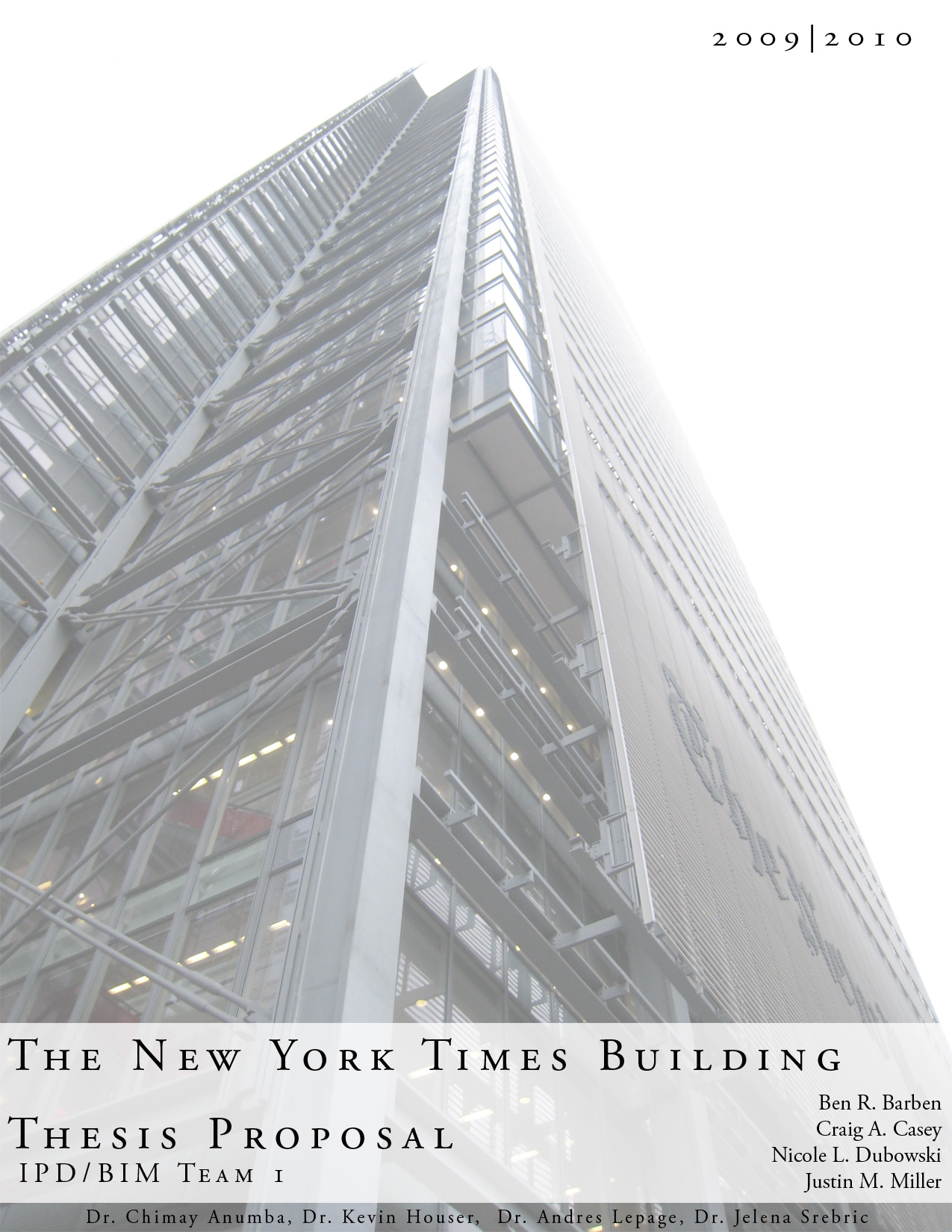IPD/BIM Thesis Proposal
The following report provides an overview of the topics that will be researched for the final IPD/BIM Team 1 Thesis on The New York Times Building. The goal will be to deliver an optimized, high performance building, adaptable to future design of the built environment. This will be measured by life-cycle cost and energy efficiency and maintain or exceed criteria for occupant safety, health and comfort, while preserving the architectural integrity of the building and the desires of the owner. These goals will be investigated through the use of the Integrated Project Delivery Method and the use of Building Information Modeling tools.
The first area of analysis is the implementation of a Building Information Modeling Execution Plan. This plan will create information flow between members of the team and enforce a schedule for each team member to guarantee completion. The collaboration between members will also be tracked, and a fully developed process map will be delivered as a final product.
The current structural system of The New York Times Building is completely comprised of steel. The gravity system redesign will investigate the elimination of structural members in a typical bay while maintaining required structural strength and serviceability. Additionally, constructability, cost implications, beam and slab penetrations for MEP will be considered to optimize the proposed system. Since the gravity system is being redesigned it will affect the lateral system, therefore a redesign will occur. Due to large lead time for the fabrication of the existing structural steel, this investigation will consider a concrete core alternative that will reduce and/or eliminate the outriggers, thermal trusses, and X-bracing to increase transparency of the building. This alternative system will have scheduling, constructability and labor implications which will be compared to the current design. Autodesk Navisworks will be utilized to develop a 4D model to display the differences between each structural system, along with the usage of the model to perform clash detection within the core for MEP wall penetrations.
Additionally, analysis will be performed to determine if changing the under-floor air distribution system to a side-wall displacement scheme will provide a more energy efficient strategy that provides better indoor air quality and thermal comfort for the occupants. Cost implications of this design change will also be addressed.
The façade of the New York Times building is one of the most notable architectural features of the building requiring collaboration between each of the disciplines. The current facade system consists of a ceramic rod shading system over a floor to ceiling ultra clear glazing system. This facade system works as an architectural element as well as a daylighting and energy control system for the interior of the building. The effects of daylight, thermal loads, structural performance, aesthetics, and cost and schedule implications will be investigated. The envelope will be studied using multiple modeling techniques to optimize performance and provide a higher level of comfort and occupant satisfaction. The use of Mixed-Mode Ventilation in a high-rise will be investigated and its implications on the building’s energy use and façade design. Furthermore, the use of renewable energy will be investigated to supplement utility fossil fuel usage, reducing the carbon footprint of the New York Times Building. An analysis on the control of direct light and shadowing will be performed. A redesign of the façade, incorporating a change in glazing, shading, and controls will be completed with use of BIM software analysis. Research will be completed to show the initial versus long-term cost implications provided by the changes. This research will also focus on developing a virtual 3D mockup to aid in the constructability of the system.
MAE Requirements
To satisfy the integrated BAE/MAE requirements, I plan to analyze integration of trichromatic glazing into the fadace. This will incorporate information learned in AE 597E: Color Science. With the idea of increasing the perception of brightness while minimizing the heat gain into the office space, this will be a great method of collaboration for the team.

IPD/BIM Thesis Proposal Revised
MAE Requirements
To satisfy the integrated BAE/MAE requirements, I plan to redesign the shading system of the New York Times and complete a daylighting analysis. The redesign will follow a literature review that will aid in the design process. The analysis will use a program, Daysim, that was recently revised by Dr. Rick Mistrick of The Pennsylvania State University. With the knowledge gained in AE 565, the analysis will help develop load profiles of the buiding as well as energy savings. The load profiles will be shared with the mechanical designer and the cost savings will be shared with the construction manager for life cycle analysis.


